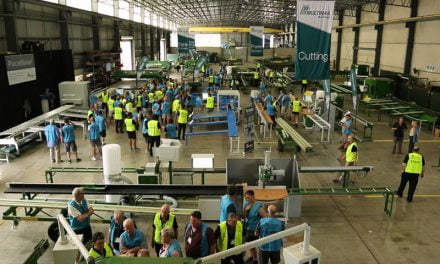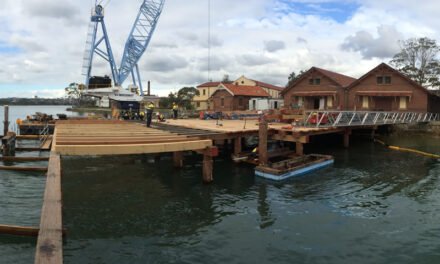The right choice in timber connectors can elevate a design aesthetically, make it easier to achieve and even make the building site safer. By Donyale Harrison
Beautiful timber structures are made by their connection choices. When the connectors used are designed to work with the architecture of the structure and show off the materials to their best advantage, everybody wins. The homeowner has a result they love, the builder has a show piece to add to their portfolio and the designer looks like a well-informed expert.
The good news is how easy this result is to obtain. Leaving aside nailplate specialists for the moment, Australia has multiple high-quality connector specialists who are all hugely invested in educating the marketplace and sharing their expertise.
We spoke with Grant Brown, national sales manager at VUETRADE, and Matt Smith, national field engineer at Simpson Strong-Tie, about some of their companies’ newest and best options, plus how connector specialists can grow your business.
CELEBRATING TIMBER
“If you’re designing timber entryways for the front of a house, or a pergola or other high-end renovation, you should be looking at our T-blade,” says Grant Brown.
“Historically, those sorts of timber posts have used stirrups or bolt-downs where you had the ugly metal sides protruding and heavy bolts running through them. Our T-blade system is almost entirely concealed: you notch the timber and the blade fits into the middle of that member. There’s a minimal foot and a neat stainless steel cap that slides over it, then everything is secured with VUEBOLTS, which have attractive rounded heads.”
The system isn’t just a significant improvement when it comes to the look of a project (see the images below), it’s also highly practical.

Above: VUETRADE’s T-blade connectors and domed VUEBOLTS deliver a strong, lasting connection without dominating the timber.

Above: The T-blade and VUEBOLT system is almost invisible, letting the timber shine while maximising its service life.
“It’s engineered 316 stainless steel, so you have a long-lasting, strong product with a very tidy finish,” Brown says. “The cap conceals the ugly bolts that are attaching the blade to the structure and the VUEBOLTS are a male-female bolt system with a T-50 head that tightens up inside the timber, leaving only the small rounded heads visible. You don’t get those protruding bolts and ends that kids can gouge their ankle on when they’re running around in the pergola or on the deck.”
Available in sizes from 90-250mm, VUEBOLTS are particularly appropriate for premium, large-section posts. In areas with strong termite activity the T-blade bolt hole locations are designed so that posts can be lifted up to 5cm from ground level to provide a physical barrier to access and an appealing ‘floating’ appearance.
“This system is gaining a lot of momentum at the moment as renos take up a bigger part of the market,” says Brown. “We’re seeing it used on pergolas and the entry points to multi-million-dollar homes, where you’ve got those beautiful bits of expressed timber and it’s such a waste to have one of those awful locking bolt downs when they could have a T-blade system with VUEBOLTS.”
VUETRADE’s wider range includes a full set of stainless-steel connectors, which makes sense given how many of us live close to the coast in Australia. “A lot of our work has been on educating people about this,” Brown says. “We’ve really started targeting builders, because that’s where it’s falling down; they’re often quite blasé about the requirements and don’t realise the importance of the standards.
“The choice between stainless steel and galvanised product sounds as though it’s just another option, but it’s super serious. I was in Yeppoon last year, talking with a customer and the inspector for the region dropped in. We went for a coffee and got talking and he told me of a wall on a fish and chip shop on the Esplanade that fell down over a walkway. It was only five years old, but they used galvanised masonry joiners. And of course, they all dissolved and, on a gusty day, it fell over. They were lucky that this was just an expensive repair, but there are serious implications of cutting corners.”
Brown knows that in some cases, the wrong choice is made in good faith, so has worked to make it easy for retailers stocking VUETRADE product to know which option to use. “Because galvanised connectors will do a great job in the right location, and they are cheaper,” he says.
“We’ve recently put in some signage at the 316 Fastening Shop in NSW. They had a big wall available and we’ve used that to put in a map that shows the areas where you need stainless steel, so now all their customers need to do is check the location of their job against the map.
“And for areas where you do need the stainless steel, homeowners can understand that if the builder takes the time to talk with them. They want a beautiful addition to their home, particularly if it’s their forever home. If you’re using gal on a deck around a salt-water pool, in five years, it’s going to fail and may injure someone. Whereas if the builder has said ‘OK, so this isn’t the cheapest, but the reason we need this is because of where the connector is located’, then homeowners are very happy with that explanation.”
PITCHING EASE
“It’s a handly little connector!” says Matt Smith, talking enthusiastically about the new Simpson Strong-Tie VGT (Variable-pitch Girder Tie). Designed to deliver a reliable tie down without creating the additional problem of brackets interfering with battens and adding to the depth of a roof profile, the VGT has proved to be even more useful than Smith was expecting.
“People have been asking if we have a solution for this need, because most other big tiedowns have to go over the top of the roof truss and can interfere with your battens,” Smith says. “But this fixes to the side of your truss, so it doesn’t clash with any of your roof material or battens. Add to that, the same bracket works for multiple pitches. There’s a U-shaped washer at the base of the bracket that can adjust from 0-35°. At the moment, a lot of other brackets, particularly in Northern Australia, are welded to the right pitch, which can be really expensive. The VGT is one product for a range of pitches.”
These sorts of connections are often positioned in the corner of structures, where the sections of the roof trusses meet and room is limited. “That’s another benefit of the VGT,” says Smith. “It alleviates those problems of restricted space, and it can tie down more than roof trusses, it would work for a beam with high uplift as well. It should predominantly see a lot of use in North Queensland, Darwin and Western Australia, anywhere you get C2, C3 or N3 and N4 wind speeds and need that extra tie-down, such as close to the coast or near a hillside.”

Smith and the Simpson Strong-Tie team have spent the better part of a year testing the VGT for compliance with local standards.
“It’s a product I’m really excited about,” Smith says, “and the few builders and frame and truss guys I’ve mentioned to have all been ‘This is great, when can we have it?’ They’ve had to wait, because we go through a really detailed testing and assurance process to make sure everything’s right for the Australian market. We test with a huge range of different grades and thicknesses of timber and at different pitches for the roofs as well, from flat to 35°, to make sure it’s compliant to the Australian standards.”
Although the VGT passed through without difficulty, that comprehensive process has been valuable for tweaking other products.
“There have been cases where something will fail prematurely, so we know it’s not right,” says Smith. “In some cases, the product isn’t suitable for our needs, but in others that testing process will show how we can improve it to meet our standards by putting in an extra screw, making it a little bit bigger or adding a reinforcing rib.”
It’s a process that has seen Simpson Strong-Tie at the forefront of introducing new types of connectors in recent years. Smith says, “We were the first ones to bring out truss screws and stud screws, and those are really useful products that have found wide acceptance. Most of our competitors also stock versions these days.”
Along with the products has come a focus on how they are used. “It’s almost a motto at Simpson’s: we want to build safer, stronger structures,” says Smith. “A big thing with that SDWC truss screw is that it can be installed by a worker on the ground using our Quik Stik. So you don’t have to work at height, there’s no need for a scaffold, the worker just walks from one location to the next and installs them all from below, which is much safer.”

Above: Using the Quik Stik, workers can install SDWC truss screws from the ground, eliminating the need to work at height and making the job faster and safer.
MAKING THE RIGHT CHOICE
Both the VUETRADE and Simpson Strong-Tie teams have found themselves having to do a lot of work on educating the broader market about the right choices for particular environments and needs.
“I sympathise with the urge to just get the job done,” says Brown, “because times are hard and they can feel as though they just need to concentrate on the next job – and by ‘they’, I mean both builders and merchants. But we see the difference that a real depth of product education makes.
“On the merchant side, look at Bowens. They spend a lot of money in training and educating their team, same with people like Narangba Timbers here in Brisbane. So they become a trusted destination for builders and landscapers and they hold onto their staff longer because they invest in them.”
Builders have different priorities, Brown says. “What we see regularly is they go out to a job, have a quick look around, submit a quote and win. And only then they do go back to get the finer details and realise, ‘Oh, jeez, we’re a stone’s throw from a waterway…’
“We know this happens because they’re time-poor, but it means that they quote on the galvanised product, but need to be using the stainless steel, which is three times the price. And sometimes they convince themselves the gal will suffice, when it won’t.
“So we’re focusing on educating the builder, because they’re the weakest link in the chain at the moment. And we’re giving them the language to talk to their clients so they understand why their builder is wanting to use stainless, or why they’re wanting to use other products, like the T-blade, that will just do a better job with a better result.”

Education has been key at Simpson Strong-Tie, too. The company’s range of free downloadable publications includes one on mass timber construction as well as several on the company’s various fastener and connector systems and there is a publication underway for high-wind zone construction that will feature the VGT bracket.
“But Simpson is probably best known for going face-to-face with a lot of different people,” says Smith. “We do training days for our larger distributors like Mitre 10. We also have a team of people who go around to building sites and show them how to use our products. We let them know that if they have any problems, they can give us a call and we’ll send someone out to them. That goes for builders, architects and engineers. So we’re training and educating at all levels of the supply chain.”
Like Brown, Smith has seen the results of their efforts: “When everybody’s on board, and the engineers and the designers understand the product and specify it correctly, then the final build flies through certification. And we help that by going to certification conferences and doing presentations on our product ranges. It all flows smoothly if everyone’s on the same page.”
Which is not to say that some people aren’t reading an entirely different book.
“I had a call from a builder the other day,” Smith says, “and he said, ‘These screws of yours are snapping!’ So we went out on site and had a look and they weren’t our screws. They’d gone and bought a cheaper version. We had to politely say, ‘Well, that’s what happens when you don’t use the proper quality screws that have been tested.’
“I don’t think they realise the implications of those sorts of substitutions, that it shifts a lot of the risk onto them. Maybe some hope for the best and they’ll jump the failure hurdle if it happens. We keep telling people that the risks aren’t worth it – so does the whole industry!”
Both have also seen more benign problems, which often have easier solutions thanks to VUETRADE and Simpsons both having in-house engineers available.
“We had one of our builder’s apprentices botch some joist hangers on a job,” says Brown. “They reached out and sent us some photos because it was going to take a huge effort to get them out and replace them. Our head engineer, Danzel Teh, spoke to them at length and actually came up with an alternative to manage the load with some modifications. It was all signed off and everyone was happy.”
But Brown and his team have also seen sub-standard product in the marketplace. “A lot of the time it’s coming in from other markets, where it might be fine for those conditions, but it hasn’t been engineered to meet Australian standards,” he says.
“It can be frustrating for local suppliers who are conscientious about meeting standards, whether that’s for tested imports or local manufacture. For example, we make our sheet material product ranges in Ballarat. And for all those sheet material products we use T300 stainless and Z275 galvanised, which are what’s required. Ours are manufactured from 1mm sheets, while people are importing 0.8mm. It’s a minuscule price difference, you’re talking a handful of dollars, but one type of product is to standard, audited and often creating local jobs and the other is all risk.”
Smith has real concerns that the wider industry will be left to manage the fallout if there are notable failures. “So far we’ve been lucky – there are some good certifiers out there picking up when the wrong product has been used, but that takes a lot of training,” he says.
“I worry there will be a failure that injures people, or worse. Because that’s what draws the attention of both negative media coverage and the government, who deal with it by putting pressure on the industry. We’ve seen the pushback when events like that occur and it damages the whole sector. There was that roof collapse at the Riverside Golf Club years ago and it resulted in a push by some people to ban roof trusses altogether. Nobody wants a repeat of that.”
FORGING NEW CONNECTIONS
Delivering innovation and education requires a strong connection with the marketplace, and both Brown and Smith say their teams prioritise communication with their whole customer base.
“We work closely with all of our partners to make sure we’re keeping up to date with building trends,” says Brown.
“Some of those trends might only last a few years, but we can often adapt a product we have already tested to make sure that it’s fit for purpose for what our partners’ customers are building.
“That may be as basic as a change to a simple joist hanger, but what that means is that the retailers who are selling VUETRADE products have what their customers want, and that’s very empowering for them.”
VUETRADE also runs a Platinum Partners program for their biggest customers. “These are customers who are often selling 100% our products and it brings them a range of benefits,” says Brown. “There are simple ones like no freight charges and no minimum orders. Then we have regular meetings where we assess their business and find ways we can help to build their business and build the timber connectors category.
“That could be the way we present in store and at the point of sale, or it could be our marketing team doing specialised and tailored social media items, that our partners can post. We streamline a lot of things that can be pain points for a lot of them, or which they don’t have time to tackle.”
There’s a similar hands-on approach for the team at Simpson Strong-Tie. “We make ourselves available,” Smith says. “Whether that’s at conferences, over the phone or on site, we talk to our customers and their customers, both so that they feel more secure in their knowledge of our products and so we can stay abreast of what they’re doing and what they might need.”
Backed up by the international parent company, Simpson has a comprehensive body of pre-tested product available that can adapt to new building trends, as well as the ability to modify existing product quickly.
Smith points to a new Meyer Timber product, meyBATTEN. “This is a new LVL roof batten product,” says Smith. “We’ve recently released a new, smaller version of the SDWS screw, the SDWS16, that works perfectly with it. It’s one of those cases where when a customer asked a question, we already had the answer in our range.”
And, for one-off designs, VUETRADE also has a custom work option. “We do a large number of custom products each year,” says Brown. “With our testing facility and our engineers based here in Australia, we’re able to deliver solutions – along with diagrams and testing data – for one-off builds and we regularly provide our customers with quotes on that sort of work.”
He’s in full agreement about the importance of talking with customers: “I get around all the states and meet most of them,” Brown says. “It’s the simplest way to hear what’s actually needed out there. And our Australian-based product development and manufacturing facilities can turn that market feedback into new products.”
For both Simpson Strong-Tie and VUETRADE, time spent on research has shown results, with each having committed retail customers who derive a lot of business from stocking the brands.
“It makes sense for hardware stores to have a good relationship with a reliable connector partner,” says Brown. “Because we deliver so much added value and education, it’s an easy way for them to increase their revenue and make them a destination rather than just another hardware store.”
For more, visit https://strongtie.com.au and https://vuetrade.com
Main image: Simpson Strong-Tie’s SDWC truss screw replaces framing anchors for rafter and truss to top plate connections.











